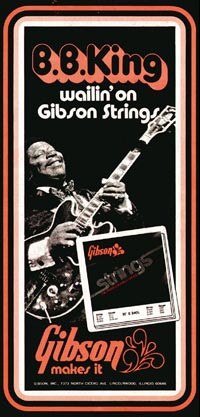

Now playing a flashy red Gibson stereo model (ES355TD), B.B. says "I like the neck, it's easy to get to the last position in a hurry." He also likes the position of the tone controls. He uses Fender Rock 'n' Roll strings because he likes an unwound "G" string. He plays with a medium-to-stiff pick, usually a tortoise shell. B.B. plays out of a Fender Twin Reverb amplifier. "I get an amp for durability and sound," he says. "I don't care too much about volume. I want it when I want it, but I like a mellow sound. I like the tone quality. I use one amp with the two channels for the stereo effect. I put one channel on bass and the other on treble, both all the way up, and as I play I mix them according to the way I hear it. But I use my guitar controls for that."
King appeared in quite a lot of Gibson's own publicity material: advertisements, catalogues and in-house magazines.
Left: 1972 Gibson advertisement. The man: B. B. King. The woman: Lucille, the King's Gibson guitar. They've been places few ever dream of getting.
In 1973 Gibson released another advertisement featuring BB King: Yeah i've paid some dues.. and when I sing Lucille understands

B.B. King is a living legend — he is the best known and most influential bluesman of them all. Since his first meeting with Sonny Boy Williamson, B.B. King's name has travelled from Memphis to Melbourne, borne by the crystal sound of his blues guitar. B.B. King was born in Itta Bena, Mississippi, on September 16, 1925. He was raised by foster parents before moving to Memphis where he met Sonny Boy Williamson, who was running a local radio programme. It was Williamson who nick-named him Blues Boy and by letting him have ten minutes of his show to play DJ, gave King his start.
Since the release of his first record, Miss Martha King, in 1949, B.B.'s fame has spread far. A procession of blues classics established him as the leading bluesman in the US. He did not play the rough-edged, raw blues of Muddy Waters but borrowed from the style of Charlie Christian to produce a clean, almost jazzy style that built his white audience nearly as big as his black following. He has played with scores of young guitarists as well as his more experienced contemporaries. One name is always associated with him, though. It's Lucille. From the beginning, B.B. King has played Gibsons. He has made the Gibson ES-3S5 famous. He now plays a custom model that Gibson made specially for him, it is called Lucille and is one of a kind. As he did more than 30 years ago, B.B. King helps make the Gibson name great.

Left: Gibson String advertisement from 1970. BB King plays his Gibson ES-355TD-SV - "wailin' on Gibson strings"
Right: The 1975 Gibson catalog consisted a selection of different brochures, each covering a single segment of their product range, and each with a different celebrity endorsing artist on the cover. BB King was featured, naturally playing a Walnut brown ES-355TD-SV on the cover of the Thin Electric Acoustic Series catalog.
BB King in action with a beautiful walnut ES335TDSV. This clip of The Thrill is Gone comes from the American TV show Playboy after dark. Note the bass player playing a right handed Gibson EB3 upside down!
Click in the centre to activate the clip
$15000
$32999
$9000
$2395
$21900
$1750
$8995
$9400
$27500
$38900
$16995
$6500
$1099
$989
$14495
$22495
€7800
€7800
£13087
£41800